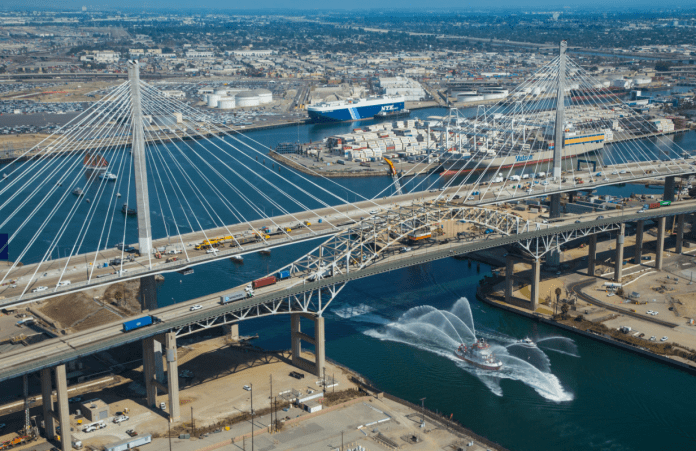The process to reduce the center span of the Gerald Desmond Bridge has begun, marking the first step toward demolishing a critical transportation link that has fueled the growth of the Port of Long Beach for half a century.
The 125-meter-long main span was disconnected from the rest of the bridge and on 9 July was being slowly brought down in one piece to be placed onto a massive barge in the water 47 meters below. The entire operation is requiring a two-day closure of the Port’s Back Channel, the waterway beneath the bridge.
The bridge closed in October 2020 when its replacement opened, and full demolition is expected to be completed by the end of 2023.
“This moment has been 20 years in the making, from the time we started planning to replace the Gerald Desmond with a taller, wider and safer bridge that would allow the Port of Long Beach to remain competitive for years to come,” said Port of Long Beach executive director Mario Cordero.
“Like its predecessor, the new bridge is a critical link in the global supply chain and Southern California’s regional transportation network,” he added.
The Gerald Desmond Bridge opened in 1968 and was named after a former Long Beach city attorney and councilman who helped secure funding for the construction of the arch bridge that connected Long Beach and Terminal Island.
“The new bridge serves as a symbol of our ongoing commitment to strengthening our infrastructure and maintaining our position as a leader in trans-Pacific trade,” said Steven Neal, president of the Long Beach board of harbor commissioners, who added, “The Gerald Desmond Bridge served this Port well for over 50 years, and we look ahead to how its replacement will usher us into a new era of growth.”
Construction of the new bridge, which is designed to last 100 years, started in 2013, while it was planned for a decade. The replacement bridge will be taller and wider with three traffic lanes in each direction and emergency shoulders to improve truck and commuter traffic throughout the harbor.
The demolition project costs US$59.9 million, a figure that is included in the US$1.57 billion budget for the design and construction of the replacement bridge.







